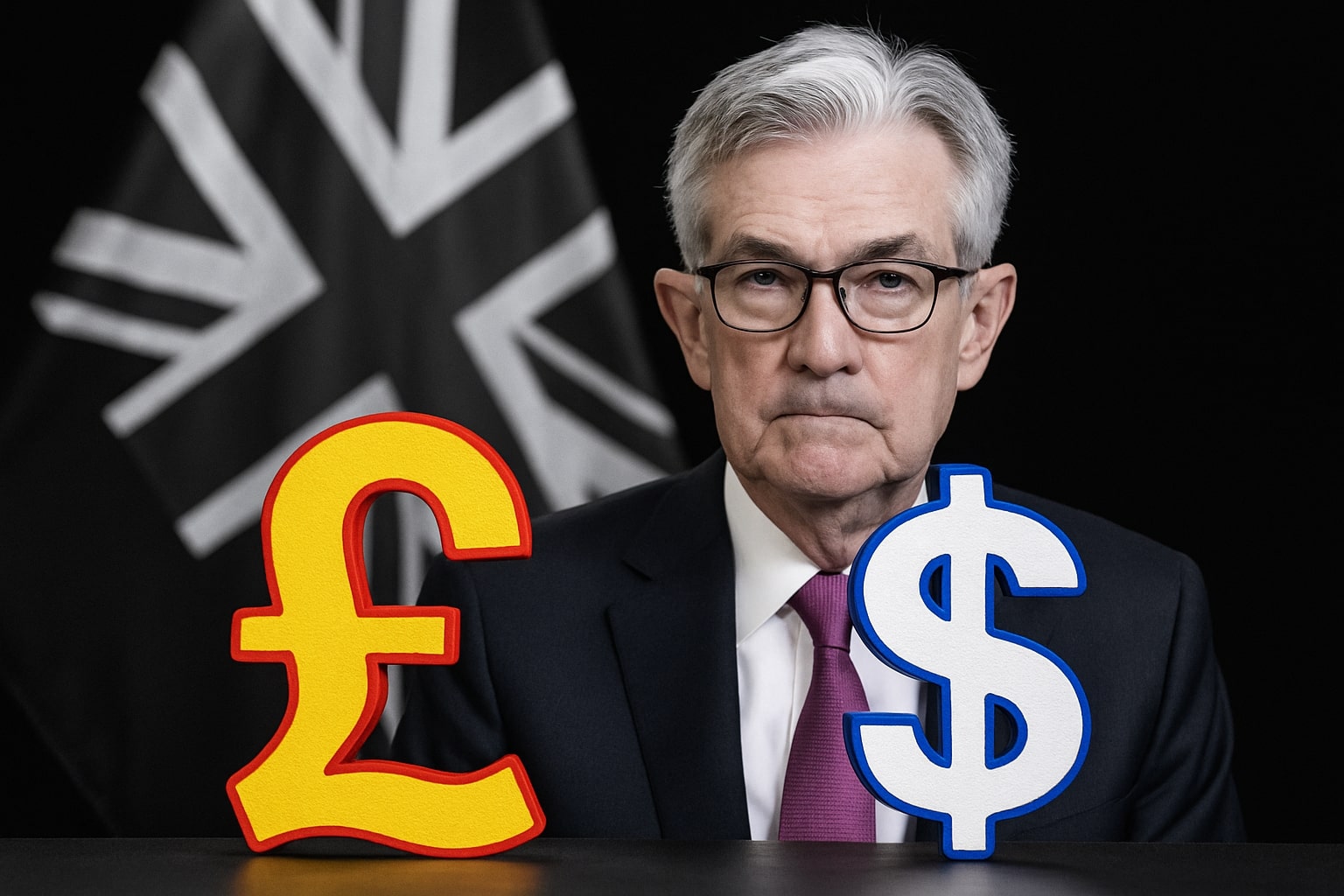
GBP/USD Price Forecast - Pound Slides to 1.3330 as Dollar Strengthens
Sterling remains trapped between 1.32 and 1.36 after a brutal week of U.S. tariff escalation, a $200B energy market wipeout, and record-breaking safe-haven flows into gold and the dollar | That's TradingNEWS
GBP/USD Price Forecast — Sterling Faces Pressure as Dollar Strengthens Amid Tariff Shock and Energy Collapse
The British pound (GBP/USD) remains under heavy pressure, currently trading around 1.3330, as traders digest the combined shock of Trump’s 100% tariffs on Chinese goods, a deep oil market collapse, and the Gaza ceasefire, which has erased much of the global risk premium. The move follows a volatile week where the pound oscillated between 1.32 and 1.36, struggling to find direction as macro forces continue to favor the U.S. dollar. While the open-market parity reading of 0.75 GBP per USD confirms technical equivalence near 1.3333, the broader structure shows persistent U.S. strength.
The Macro Landscape Behind GBP/USD — Tariffs, Energy Shock, and Global Risk Aversion
A rapid shift in sentiment has unfolded since Trump announced the 100% tariff regime on Chinese imports. The resulting trade retaliation—China’s ¥400 per tonne ($56/mt) port surcharge and expanded rare earth export restrictions—has rattled global trade and hit risk assets. Oil collapsed in tandem: WTI crude (CL=F) fell 4.24% to $58.90 per barrel, while Brent (BZ=F) dropped 3.82% to $62.73, their lowest levels since May. The breakdown wiped out nearly $200 billion in global energy market capitalization, dragging down commodity-linked currencies and boosting the safe-haven U.S. dollar.
The Gaza ceasefire further accelerated the shift. Traders quickly removed the geopolitical risk premium that had buoyed crude and metals for weeks, triggering a flight to safety. Gold (XAU/USD) surged beyond $4,000 per ounce, its highest ever, while silver touched $49.55 before retracing slightly. Such flows toward hard assets and the U.S. dollar typically weigh on sterling, amplifying pressure on GBP/USD as global portfolios pivoted out of risk.
Why Sterling Struggles Despite Lower Energy Prices — Trade Exposure and Yield Spread Dynamics
Theoretically, lower oil prices should help energy-importing economies like the U.K., easing inflation and improving the current account. Yet the data tell a different story: capital outflows from risk-sensitive assets continue, and dollar funding remains scarce. The DXY index has climbed steadily, while USD/JPY trades above ¥152, its highest level since 1990, signaling broad-based dollar demand. The pound’s limited yield advantage—only 0.40% above U.S. Treasuries at the 10-year tenor—offers little cushion. As risk-off sentiment intensifies, global investors prefer the dollar’s liquidity over the pound’s modest carry.
The U.K.’s trade exposure amplifies the downside. Nearly 47% of its exports depend on European and Asian demand, both now threatened by slower growth and tariff escalation. That means any slump in global trade flows can translate directly into weaker sterling, even if domestic fundamentals look steady.
Technical Picture of GBP/USD — The Battle Between 1.32 and 1.36 Defines Direction
The chart setup for GBP/USD is clear: the pair remains locked between 1.3200 support and 1.3600 resistance, a decisive band controlling short-term momentum. The 50-day moving average rests at 1.3460, while the 200-day sits near 1.3335, placing spot almost directly on its long-term mean. A sustained daily close below 1.3200 would signal a trend reversal toward 1.3050 and possibly 1.3000, levels last seen before the spring rally. Conversely, a breakout above 1.3600 would confirm renewed bullish momentum, opening a path to 1.3800 and 1.4000.
Trading desks report that large institutional orders cluster around these levels, with options open interest concentrated between 1.33–1.35, reinforcing current range compression. Volatility metrics confirm the pressure: one-week implied vols sit near 8.6%, up sharply from 6% last month, highlighting traders’ uncertainty ahead of key tariff and energy developments.
Read More
-
JEPQ ETF Holds $58.82 as Fund Flows Cool and Nasdaq Valuations Stretch
06.12.2025 · TradingNEWS ArchiveStocks
-
XRP ETFs Cross $1 Billion AUM as XRPI and XRPR Lead Institutional Wave
06.12.2025 · TradingNEWS ArchiveCrypto
-
Natural Gas Price Breakout: NG=F Soars to $5.50 on Cold U.S. Weather & LNG Export Boom
06.12.2025 · TradingNEWS ArchiveCommodities
-
USD/JPY Price Forecast - Dollar to yen Slides to 155.60, BOJ Hike Reprice Global Currency Markets
06.12.2025 · TradingNEWS ArchiveForex
Fundamental Correlations — Commodities, Metals, and Cross-Asset Flow
Energy and metals correlations dominate this cycle. The sharp fall in crude oil coincides with the surge in gold, creating a divergence that has historically preceded USD uptrends. Each $5 move lower in Brent has historically reduced the U.K.’s net trade surplus by roughly £650 million, pressuring GBP/USD indirectly through fiscal channels. Meanwhile, gold’s 53% year-to-date gain to $4,012 per ounce reflects a broad risk-off shift that reinforces the dollar’s haven appeal.
Cross-currency comparisons further expose the pound’s weakness. EUR/USD slid below 1.16, USD/JPY surged above ¥152, and USD/CAD reclaimed 1.40, confirming U.S. dollar dominance across majors. For sterling, that makes every rebound above 1.35 an uphill struggle.
Market Positioning — Hedge Funds Reduce Sterling Longs as Macro Funds Add USD Exposure
CFTC data reveal a decisive change in speculative flow: net long positions in sterling futures have dropped 17% month-over-month, while USD net longs expanded 22%. The unwind reflects both fading confidence in U.K. growth and systematic models reallocating toward dollar strength. Hedge funds now view GBP/USD as a relative short within a global risk hedge basket that includes long USD/JPY and short EUR/USD.
Institutional clients also continue shifting portfolios toward U.S. bonds. Treasury inflows of $23 billion in the past two weeks signal confidence that the Fed’s cautious stance will keep yields attractive. By contrast, gilts remain under foreign selling pressure, pushing the U.K. 10-year yield up to 4.28%, narrowing the premium advantage that once supported the pound.
Key Economic Catalysts — What Can Move GBP/USD Next
Markets await clarity on three immediate fronts. First, the Trump–Xi trade summit later this month will determine whether tariffs intensify or pause, setting the tone for dollar liquidity. Second, U.K. CPI and wage growth data next week will test whether inflation is moderating fast enough to justify a Bank of England rate cut in Q1 2026. Third, U.S. retail sales and PPI figures will gauge the strength of American consumption—the backbone of the dollar’s resilience.
If U.S. data outperform again while U.K. prints soften, the yield gap will widen further, likely dragging GBP/USD toward the 1.31–1.30 area. Conversely, a dovish Fed tone or stronger U.K. inflation surprise could spark a short-covering rally toward 1.36–1.38, though sustaining those gains will require broader risk appetite to return.
Trading Strategy — Range-Bound Playbook with Event-Driven Bias
For now, professional traders are favoring tactical range strategies around the 1.32–1.36 corridor. Buying dips near 1.3250 with tight stops under 1.3175 and targets at 1.3450 offers a positive 1:2.5 risk/reward, while fading spikes near 1.3600–1.3620 with stops above 1.3680 targets 1.3400–1.3300 efficiently within the current volatility structure. A daily close outside this zone should trigger trend-following entries in the breakout direction.
Macro Outlook and Market Psychology — Sterling’s Role in a Dollar-Dominated Cycle
The tone of global markets remains defensive. Investors are parking capital in U.S. dollar-denominated assets, fueled by geopolitical anxiety and trade disruption. Despite the potential domestic benefit of cheaper energy imports, the U.K. economy remains hostage to global flows and investor confidence. As long as gold trades above $4,000, WTI stays under $60, and USD/JPY holds above ¥152, the probability favors continued U.S. dollar dominance.
Final Assessment on GBP/USD — Between Relief and Risk
Sterling is trapped between conflicting narratives: fundamental undervaluation versus a world that keeps rewarding dollar liquidity. The immediate data signal consolidation, not collapse, but momentum remains dollar-sided. Until GBP/USD reclaims a clear daily close above 1.3600, rallies should be treated as opportunities to sell strength, not chase reversals. A sustained breach below 1.3200 would confirm renewed downside momentum toward 1.3050–1.3000, levels aligning with the broader risk-off sentiment across commodities and equities.
Verdict: HOLD with Bearish Bias — GBP/USD trades defensively between 1.32–1.36. Upside capped by policy uncertainty, tariff escalation, and risk aversion, while near-term rebounds remain tactical amid stronger U.S. fundamentals and safe-haven flows.



















